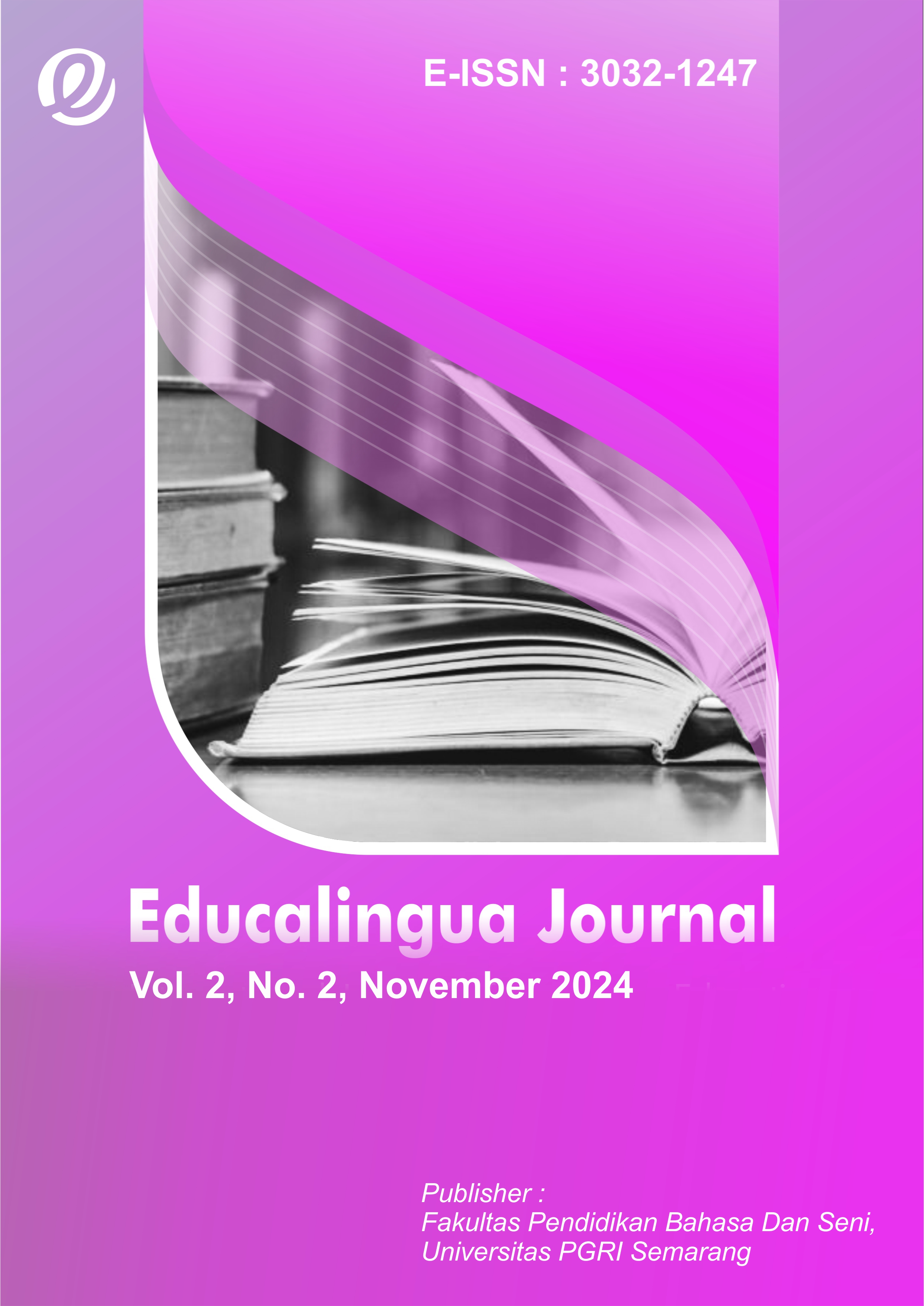EFL Students’ Perception Towards Kahoot! as A Gamification Tool in English Learning
DOI:
https://doi.org/10.26877/educalingua.v2i2.1214Keywords:
English language teaching, Kahoot!, gamification tool, students' perceptionAbstract
Technology in education forces teachers to modify their teaching strategies by implementing gamification as a tool in teaching and learning process. Kahoot is a popular gamification tool in English learning. Using a qualitative research design, this study aimed to determine the EFL students' perception of the gamification tool in an English learning environment. Thirty-six (36) students of 10th grade from a public senior high school in Semarang, Central Java, Indonesia. The participants were asked to complete a closed-ended questionnaire using Google Forms to gain information about their perceptions of the educational environment. The findings revealed that the students generally have a positive perception of Kahoot! as a gamification tool in the English learning process. The interactive and competitive nature of the quizzes increases students' motivation and engagement in the learning process, which can enhance students' engagement and motivation in the classroom. The students generally perceive Kahoot! as an effective, fun, and effective educational environment that enhances students' learning experience and creates a vibrant and engaging classroom environment. By combining motivation, collaboration, competition, fun, interest, excitement, and an energetic environment, Kahoot! can enhance the English learning experience, promote interaction and collaboration, and offer customizable features.
References
Ali, M. F., Askary, G., Mehdi, H., Khan, A., Kaukab, H., & Qamar, R. (2021). To Assess Students Perception about Kahoot! as An Innovative Learning Tool in Oral Pathology-a Qualitative Study. Journal of the Pakistan Medical Association, 71(10), 2426–2428. https://doi.org/10.47391/JPMA.01-194
Asniza, I. N., Zuraidah, M. O. S., Baharuddin, A. R. M., Zuhair, Z. M., & Nooraıda, Y. (2021). Online Game-Based Learning Using Kahoot! to Enhance Pre-University Students’ Active Learning: A Students’ Perception in Biology Classroom. Journal of Turkish Science Education, 18(1), 145–160. https://doi.org/10.36681/tused.2021.57
Basuki, Y., & Hidayati, Y. (2019, July 9). Kahoot! or Quizizz: the Students’ Perspectives. https://doi.org/10.4108/eai.27-4-2019.2285331
Bicen, H., & Kocakoyun, S. (2018). Perceptions of students for gamification approach: Kahoot as a case study. International Journal of Emerging Technologies in Learning, 13(2), 72–93. https://doi.org/10.3991/ijet.v13i02.7467
Cameron, K. E., & Bizo, L. A. (2019). Use of the game-based learning platform KAHOOT! to facilitate learner engagement in animal science students. Research in Learning Technology, 27. https://doi.org/10.25304/rlt.v27.2225
Creswell, J. W. (2013). Educational Research: Planning, Conducting and Evaluating Quantitative and Qualitative Research (4th Editio). Pearson
Dani, V. (2019). 9 Trends in Education Technology That Will Have A Major Impact in 2023. Kitaboo.Com. https://kitaboo.com/trends-in-education-technology/
Dellos, R. (2015). Kahoot! A Digital Game for Learning. International Journal of Technology and Distance Learning, 12(4), 49–52.
Donkin, R., & Rasmussen, R. (2021). Student Perception and the Effectiveness of Kahoot!: A Scoping Review in Histology, Anatomy, and Medical Education. Anatomical Sciences Education, 14(5), 572–585. https://doi.org/10.1002/ase.2094
Firdaus, M. S., Wiyaka, & Prastikawati, E. F. (2022). Online Formative Assessments in English Teaching and Learning. SALEE: Study of Applied Linguistics and English Education, 3(1), 1–12. https://doi.org/10.35961/salee.v3i1.385
Fuster-Guilló, A., Pertegal-Felices, M. L., Jimeno-Morenilla, A., Azorín-López, J., Rico-Soliveres, M. L., &
Restrepo-Calle, F. (2019). Evaluating Impact on Motivation and Academic Performance of a Game-Based Learning Experience Using Kahoot. Frontiers in Psychology, 10. https://doi.org/10.3389/fpsyg.2019.02843
Hadijah, H., Pratolo, B. W., & Rondiyah, R. (2020). Interactive game “Kahoot!” as the media of students’ vocabulary assessment. Journal on English as a Foreign Language, 10(1), 87–105. https://doi.org/10.23971/jefl.v10i1.1670
Jain, A., & Dutta, D. (2019). Millennials and Gamification: Guerilla Tactics for Making Learning Fun. South Asian Journal of Human Resources Management, 6(1), 29–44. https://doi.org/10.1177/2322093718796303
Kaur, P., & Naderajan, R. (n.d.). KAHOOT! IN THE ENGLISH LANGUAGE CLASSROOM. South East Asia Journal of Contemporary Business, Economics and Law, 20(6).
Li, X., & Chu, S. K. W. (2021). Exploring the effects of gamification pedagogy on children’s reading: A mixed-method study on academic performance, reading-related mentality and behaviors, and sustainability. British Journal of Educational Technology, 52(1), 160–178. https://doi.org/10.1111/bjet.13057
Lofti, T. M., Pratolo, B. W., & Dahlan, U. A. (2021). Students’ Perceptions Toward The Use of Kahoot! Online Game for Learning English Corresponding Email Article’s History Students’ Perceptions Toward the Use of Kahoot! Online Game for Learning English. Ethical Lingua, 8(1), 2021.
Mahbubah, L., & Anam, S. (2022). STUDENTS’ PERCEPTIONS ON THE IMPLEMENTATION OF KAHOOT! IN ENGLISH LANGUAGE TEACHING (Vol. 29, Issue 1).
Novrianti, N. (2021). Kahoot App as a Digital Evaluation Alternative For Online Learning. Jurnal Educative: Journal of Educational Studies, 6(1), 84. https://doi.org/10.30983/educative.v6i1.4646
Nurhadianti, & Pratolo, B. W. (2020). Students’ perception toward the application of Kahoot! As an assessment tool in EFL class. Universal Journal of Educational Research, 8(5), 2150–2155. https://doi.org/10.13189/ujer.2020.080554
Onyema, E. M., Eucheria, N. C., Obafemi, F. A., Sen, S., Atonye, F. G., Sharma, A., & Alsayed, A. O. (2020). Impact of Coronavirus Pandemic on Education. Journal of Education and Practice, 11(13), 108–121. https://doi.org/10.7176/jep/11-13-12
Rapp, A., Hopfgartner, F., Hamari, J., Linehan, C., & Cena, F. (2019). Strengthening gamification studies: Current trends and future opportunities of gamification research. In International Journal of Human Computer Studies (Vol. 127, pp. 1–6). Academic Press. https://doi.org/10.1016/j.ijhcs.2018.11.007
Redjeki, I. S., & Muhajir, R. (2021). Gamification in EFL classroom to support teaching and learning in 21st century. JEES (Journal of English Educators Society), 6(1), 68–78. https://doi.org/10.21070/jees.v6i1.882
Rincon-Flores, E. G., & Santos-Guevara, B. N. (n.d.). Gamification during Covid-19: Promoting active learning and motivation in higher education. In Australasian Journal of Educational Technology (Vol. 2021, Issue 5).
Smirdele, R., Rigo, S., Marques, L., Pecanha de Miranda Coelho, J., & Jaques, P. (2020). Gamification of Education Has the Potential to Boost Learning, Improve Certain Skills, and Promote Student Engagement. Smart Learning Environments, 7(1).
Tetep, T., & Arista, Y. (2022). Students’ Perception towards Kahoot Learning Media and Its Influence towards Students’ Motivation in Learning Social Studies and Civic Education amid Pandemic in SMKN 9 Garut. The Innovation of Social Studies Journal, 4(1), 99–108.
Wang, A. I., & Tahir, R. (2020). The effect of using Kahoot! for learning – A literature review. Computers and Education, 149. https://doi.org/10.1016/j.compedu.2020.103818
Zhang, Q., & Yu, Z. (2021). A Literature Review on the Influence of Kahoot! On Learning Outcomes, Interaction, and Collaboration. Education and Information Technologies, 26(4), 4507–4535.





